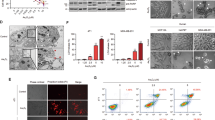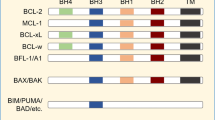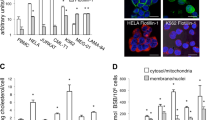Abstract
This study explores the roles of Bax and other Bcl-2 family members play in arsenic trioxide (As2O3)-induced apoptosis. We showed that As2O3 treatment triggered Bax conformational change and subsequent translocation from cytosol to mitochondria to form various multimeric homo-oligomers in IM-9 cells. On the other hand, human leukemic Jurkat cells deficient in Bax showed dramatically reduced apoptosis in response to As2O3. Stable overexpression of Bcl-2 in IM-9 cells (IM-9/Bcl-2) inhibited As2O3-mediated Bax activation and apoptosis, and this inhibition could be partially averted by cell-permeable Bid-Bcl-2 homology (BH)3 peptide. Meanwhile, Bax conformational change and oligomerization induced by As2O3 were not inhibited by the pancaspase inhibitor z-VAD-fmk, although Bid cleavage could be completely abolished. Bax activation by As2O3 seemed to require stress-induced intracellular reactive oxygen species (ROS), since the ROS scavengers (N-acetyl-L-cysteine and lipoic acid) could completely block the conformational change and translocation of Bax from cytosol to mitochondria. These data suggest that As2O3 might exert the cell killing in part by inducing Bax activation through a Bcl-2-suppressible pathway in hematopoietic cells that is caspase independent and intracellular ROS regulated.
This is a preview of subscription content, access via your institution
Access options
Subscribe to this journal
Receive 50 print issues and online access
$259.00 per year
only $5.18 per issue
Buy this article
- Purchase on Springer Link
- Instant access to full article PDF
Prices may be subject to local taxes which are calculated during checkout







Similar content being viewed by others
References
Adams JM and Cory S . (2001). Trends Biochem. Sci., 26, 61–66.
Akao Y, Mizoguchi H, Kojima S, Naoe T, Ohishi N and Yagi K . (1998). Br. J. Haematol., 102, 1055–1060.
Anderson KC, Boise LH, Louie R and Waxman S . (2002). Cancer J., 8, 12–25.
Antonsson B, Montessuit S, Sanchez B and Martinou JC . (2001). J. Biol. Chem., 276, 11615–11623.
Bellosillo B, Villamor N, Lopez-Guillermo A, Marce S, Bosch F, Campo E, Montserrat E and Colomer D . (2002). Blood, 100, 1810–1816.
Buccellato LJ, Tso M, Akinci OI, Chandel NS and Budinger GR . (2004). J. Biol. Chem., 279, 6753–6760.
Chen Q, Chai YC, Mazumder S, Jiang C, Macklis RM, Chisolm GM and Almasan A . (2003). Cell Death Differ., 10, 323–334.
Chen Q, Gong B and Almasan A . (2000). Cell Death Differ., 7, 227–233.
Chen Q, Takeyama N, Brady G, Watson AJ and Dive C . (1998a). Blood, 92, 4545–4553.
Chen Q, Turner J, Watson AJ and Dive C . (1997). Oncogene, 15, 2249–2254.
Chen YC, Lin-Shiau SY and Lin JK . (1998b). J. Cell. Physiol., 177, 324–333.
Cheng EH, Sheiko TV, Fisher JK, Craigen WJ and Korsmeyer SJ . (2003). Science, 301, 513–517.
Costantini P, Chernyak BV, Petronilli V and Bernardi P . (1996). J. Biol. Chem., 271, 6746–6751.
Dai J, Weinberg RS, Waxman S and Jing Y . (1999). Blood, 93, 268–277.
Desagher S and Martinou JC . (2000). Trends Cell Biol., 10, 369–377.
Desagher S, Osen-Sand A, Nichols A, Eskes R, Montessuit S, Lauper S, Maundrell K, Antonsson B and Martinou JC . (1999). J. Cell Biol., 144, 891–901.
Dewson G, Snowden RT, Almond JB, Dyer MJ and Cohen GM . (2003). Oncogene, 22, 2643–2654.
Doza YN, Hall-Jackson CA and Cohen P . (1998). Oncogene, 17, 19–24.
Eskes R, Desagher S, Antonsson B and Martinou JC . (2000). Mol. Cell. Biol., 20, 929–935.
Green DR and Reed JC . (1998). Science, 281, 1309–1312.
Gross A, Jockel J, Wei MC and Korsmeyer SJ . (1998). EMBO J., 17, 3878–3885.
Heibein JA, Goping IS, Barry M, Pinkoski MJ, Shore GC, Green DR and Bleackley RC . (2000). J. Exp. Med., 192, 1391–1402.
Hockenbery DM, Oltvai ZN, Yin XM, Milliman CL and Korsmeyer SJ . (1993). Cell, 75, 241–251.
Hsu YT and Youle RJ . (1997). J. Biol. Chem., 272, 13829–13834.
Hsu YT and Youle RJ . (1998). J. Biol. Chem., 273, 10777–10783.
Huang DC and Strasser A . (2000). Cell, 103, 839–842.
Jing Y, Dai J, Chalmers-Redman RM, Tatton WG and Waxman S . (1999). Blood, 94, 2102–2111.
Kirkland RA, Windelborn JA, Kasprzak JM and Franklin JL . (2002). J. Neurosci., 22, 6480–6490.
Larochette N, Decaudin D, Jacotot E, Brenner C, Marzo I, Susin SA, Zamzami N, Xie Z, Reed J and Kroemer G . (1999). Exp. Cell Res., 249, 413–421.
Li H, Zhu H, Xu CJ and Yuan J . (1998). Cell, 94, 491–501.
Li YM and Broome JD . (1999). Cancer Res., 59, 776–780.
Luo X, Budihardjo I, Zou H, Slaughter C and Wang X . (1998). Cell, 94, 481–490.
Maeda H, Hori S, Ohizumi H, Segawa T, Kakehi Y, Ogawa O and Kakizuka A . (2004). Cell Death Differ., 11, 737–746.
Makin GW, Corfe BM, Griffiths GJ, Thistlethwaite A, Hickman JA and Dive C . (2001). EMBO J., 20, 6306–6315.
Mikhailov V, Mikhailova M, Pulkrabek DJ, Dong Z, Venkatachalam MA and Saikumar P . (2001). J. Biol. Chem., 276, 18361–18374.
Miller Jr WH, Schipper HM, Lee JS, Singer J and Waxman S . (2002). Cancer Res., 62, 3893–3903.
Murphy KM, Streips UN and Lock RB . (2000). J. Biol. Chem., 275, 17225–17228.
Perkins C, Kim CN, Fang G and Bhalla KN . (2000). Blood, 95, 1014–1022.
Petronilli V, Costantini P, Scorrano L, Colonna R, Passamonti S and Bernardi P . (1994). J. Biol. Chem., 269, 16638–16642.
Priault M, Cartron PF, Camougrand N, Antonsson B, Vallette FM and Manon S . (2003). Cell Death Differ., 10, 1068–1077.
Quignon F, De Bels F, Koken M, Feunteun J, Ameisen JC and de The H . (1998). Nat. Genet., 20, 259–265.
Roucou X, Rostovtseva T, Montessuit S, Martinou JC and Antonsson B . (2002). Biochem. J., 363, 547–552.
Rousselot P, Labaume S, Marolleau JP, Larghero J, Noguera MH, Brouet JC and Fermand JP . (1999). Cancer Res., 59, 1041–1048.
Shen ZX, Chen GQ, Ni JH, Li XS, Xiong SM, Qiu QY, Zhu J, Tang W, Sun GL, Yang KQ, Chen Y, Zhou L, Fang ZW, Wang YT, Ma J, Zhang P, Zhang TD, Chen SJ, Chen Z and Wang ZY . (1997). Blood, 89, 3354–3360.
Shi Y, Chen JJ, Chen R, Weng CJ, Zheng YH, Chen Q and Tang H . (2003). Biochem. Biophys. Res. Commun., 305, 989–996.
Shimizu S, Matsuoka Y, Shinohara Y, Yoneda Y and Tsujimoto Y . (2001). J. Cell Biol., 152, 237–250.
Soignet SL, Maslak P, Wang ZG, Jhanwar S, Calleja E, Dardashti LJ, Corso D, DeBlasio A, Gabrilove J, Scheinberg DA, Pandolfi PP and Warrell Jr RP . (1998). N. Engl. J. Med., 339, 1341–1348.
Tsujimoto Y and Shimizu S . (2002). Biochimie, 84, 187–193.
Vander Heiden MG and Thompson CB . (1999). Nat. Cell Biol., 1, E209–E216.
Voehringer DW and Meyn RE . (2000). Antioxid. Redox Signal., 2, 537–550.
Wang K, Yin XM, Chao DT, Milliman CL and Korsmeyer SJ . (1996). Genes Dev., 10, 2859–2869.
Woo SH, Park IC, Park MJ, Lee HC, Lee SJ, Chun YJ, Lee SH, Hong SI and Rhee CH . (2002). Int. J. Oncol., 21, 57–63.
Xia T, Jiang CS, Li LJ, Zhang Y, Jin HJ, Liu SS, Wu CH and Chen Q . (2002). Chinese Sci. Bull., 47, 553–557.
Yamaguchi H, Bhalla K and Wang HG . (2003). Cancer Res., 63, 1483–1489.
Yamaguchi H, Paranawithana SR, Lee MW, Huang Z, Bhalla KN and Wang HG . (2002). Cancer Res., 62, 466–471.
Yamaguchi H and Wang HG . (2001). Oncogene, 20, 7779–7786.
Yamaguchi H and Wang HG . (2002). J. Biol. Chem., 277, 41604–41612.
Yang J, Liu X, Bhalla K, Kim CN, Ibrado AM, Cai J, Peng TI, Jones DP and Wang X . (1997). Science, 275, 1129–1132.
Zhang TD, Chen GQ, Wang ZG, Wang ZY, Chen SJ and Chen Z . (2001). Oncogene, 20, 7146–7153.
Zheng Y, Shi Y, Tian C, Jiang C, Jin H, Chen J, Almasan A, Tang H and Chen Q . (2004). Oncogene, 23, 1239–1247.
Acknowledgements
We are grateful to Dr Alex Almasan (Department of Cancer Biology, Cleveland Clinic, USA) for his thoughtful comments. We wish to thank Mrs J Wang, Xiaohui Wang and Haijing Jin for their technical assistance. This work was supported by grants of the National Proprietary Research Program (973 program project, No. 2002CB513100 and 2004CB720003) and National Outstanding Young Investigator Fellowship (No. 30325013) from NSFC awarded to QC, ‘Knowledge Innovation Key Project’ (Kscx2-sw-2010) of Chinese Academy of Sciences, and the National Outstanding Young Oversea Investigator Fellowship to H-GW (No. 30228010). H-GW is supported by National Cancer Center Grants CA82197 and CA90315.
Author information
Authors and Affiliations
Corresponding author
Rights and permissions
About this article
Cite this article
Zheng, Y., Yamaguchi, H., Tian, C. et al. Arsenic trioxide (As2O3) induces apoptosis through activation of Bax in hematopoietic cells. Oncogene 24, 3339–3347 (2005). https://doi.org/10.1038/sj.onc.1208484
Received:
Revised:
Accepted:
Published:
Issue Date:
DOI: https://doi.org/10.1038/sj.onc.1208484
Keywords
This article is cited by
-
Enhanced mild-temperature photothermal therapy by pyroptosis-boosted ATP deprivation with biodegradable nanoformulation
Journal of Nanobiotechnology (2023)
-
Oxidative stress-mediated intrinsic apoptosis in human promyelocytic leukemia HL-60 cells induced by organic arsenicals
Scientific Reports (2016)
-
SapC-DOPS nanovesicles induce Smac- and Bax-dependent apoptosis through mitochondrial activation in neuroblastomas
Molecular Cancer (2015)
-
Bim and VDAC1 are hierarchically essential for mitochondrial ATF2 mediated cell death
Cancer Cell International (2015)
-
OPA1 downregulation is involved in sorafenib-induced apoptosis in hepatocellular carcinoma
Laboratory Investigation (2013)



